What I Saw in Iran
The worst part about taking a two-week vacation to Iran happens before you ever set foot in the country. “Oh really, where are you going?” people inevitably ask over the course of a normal conversation.
And then you tell them.
Almost every response is the same: incredulity followed by a splash of gallows humor—literally, in some cases. (“Don’t get hanged! LOL!”) Some are more sophisticated (“Be sure to forward your new address at Evin Prison”) than others (“Watch out for ISIS!”). Some people are clearly joking, while others seem legitimately concerned.
At a certain point, if you’re paranoid enough, you start taking them all seriously. This is especially true if you happen to have ties to an obscure warmongering Kate Upton blog whose coverage of the Iranian regime has been less than flattering, and who employs this man. What have you gotten yourself into? Let’s see what the State Department has to say:
Some elements in Iran remain hostile to the United States. As a result, U.S. citizens may be subject to harassment or arrest while traveling or residing in Iran.
Jason Rezaian can certainly attest to this fact. The dual Iranian-American citizen and Washington Post bureau chief has spent the better part of a year in jail on unknown charges. You don’t want to end up like him. For example, what if the nuclear talks go south in a hurry after John Kerry gets tired of being yelled at all the time and takes his windsurfing board out on Lake Geneva to shred away his sorrow? Maybe the ayatollahs fancy an extra bargaining chip?
You imagine being thrown in Evin Prison for a year or twenty, and conclude that it’s probably not very nice. On the other hand, it could be a brilliant career move. Just ask Winston Churchill. The book advance would be nothing to scoff at. The screenplay would win all of the awards and tear at the heartstrings. That scene where you visit your parents’ graves? Man, that’s dark. Or meeting your girlfriend’s children like in Cast Away. Being perplexed by all the new technology, and then longing for the dreary solace of your cell while watching President Chelsea Clinton being sworn in for a second term.
But eventually—as in, a couple hours before takeoff—you consider the possibility that you should chill the f—k out. This particular Persian excursion, after all, is sponsored by none other than the New York Times, the esteemed paper of record that, in case you hadn’t noticed, is quickly transforming itself into a travel agency of some renown, offering an array of exhilarating (and expensive) cultural journeys for the sophisticated traveller.
Looking for a “people to people experience” in communist Cuba? The Times has you covered. Eager to help solve the Israeli-Palestinian conflict? Ditto. Keen to “retrace the footsteps of some of the world’s greatest explorers” in Antarctica? There’s a trip for that. It’s not clear whose footsteps you’ll be retracing aboard the “297-foot luxury expedition yacht” the Times has commissioned, but why quibble? Rates start at $15,695. Carlos Slim must be loving this.
No Times Journey, as they’re called, is as popular as “Tales from Persia.” Ours is the inaugural voyage, but there’s been so much interest that they’ve already had to increase the number of offerings this year from three to five, all of which are sold out. At the end of the day, no one—not even the ayatollah—is going to f—k with the Times. That’s what you’re counting on, anyway. Although the Gray Lady has certainly gone to great lengths to ensure her release from liability:
Without limitation, we are not responsible for any injury, loss, or damage to personal property, death, delay or inconvenience in connection with the provision of any goods or services occasioned by or resulting from, but not limited to, acts of God, acts of government, weather, force majeure, acts of war or civil unrest, insurrection or revolt, strikes or other labor activities, criminal or terrorist activities or the threat thereof…
But even if it comes to that—getting yanked into a windowless room upon arrival at Imam Khomeini International Airport—you’ve settled on a failsafe strategy: blame everything on the Jews. Before you know it, your Qatar Airways flight to Tehran (connecting through Doha, site of the 2022 World Cup final) is preparing for takeoff. There’s a large compass displayed on a big screen at the front of the cabin. One arrow points towards Mecca, the holiest of Muslim holy sites, and another (for some reason) towards Gaithersburg, Md.
‘Welcome to Iran’

I arrive in Tehran and head straight for passport control. The ceilings are low and the lights are hot. I’m exhausted and sweating suspiciously while trying to avoid eye contact with the security camera pointed right at my face. Behind the row of guards, there’s a wall-off area marked “Fingerprinting Room.” This should be fun.
If the Iranian commitment to airport inconvenience is any indication, their willingness to embrace Western culture may be underestimated. The line I’m in is moving at an excruciating pace. So, nothing out of the ordinary. After a nerve-wracking three-quarter hours, I’m next. Until I’m not. The guard seems to be waving me over to another station, and has exquisitely timed it so that I’m just seconds too late to beat out the professional soccer team arriving from Abu Dhabi. Typical soccer. The additional forty-five minutes I’m forced to wait is only slightly more tedious than watching them play.
Finally, I am stamped through. After a brief, wordless exchange, the Iranian guard had unsuccessfully searched his desk for what I assume was the foreigner fingerprinting/detention worksheet, and could not have been less enthusiastic about the prospect of getting up from his seat to find one. I am shrugged over the line onto Iranian soil, where I collect my bag and am instantly greeted by one of our local tour guides, Cyrus, who is holding a sign with my name on it. “I was expecting someone much older,” he says. “Welcome to Iran.”
Our group of 20 is staying at the Laleh International Hotel in Tehran. Lonely Planet calls it “the best choice among the fading prerevolutionary luxury hotels.” The former InterContinental was a favorite haunt of Western visitors in the days of the shah, including the foreign journalists who accompanied Ayatollah Khomeini on his triumphant return from exile in Paris. (The New York Times reporter accompanying our group, Elaine Sciolino, was among them.) Judging by the rooms, very little has changed since the days of the Islamic Revolution. The toilets are American Standard. The plumbing, as I will soon realize, is Iranian substandard.
The television seems modern enough, so I flip on Press TV, Iran’s premiere English-language news channel. George Galloway, the cantankerous British lawmaker, is yelling about imperialism. Apparently he has his own show on the network. Galloway tries to take a call from a viewer named “Blair,” but the connection is down. Without missing a beat, he launches into a soliloquy denouncing the “treasonous” regime of Tony Blair. Galloway, who makes Ed Schultz seem sedate by comparison, insists the former prime minister “will be brought to justice,” before reminding viewers that he’s up for reelection to the House of Commons in May.
As much as I’d like to keep watching, it’s getting late, and before I turn in for the night I need to get online and let the folks back home know that I’ve arrived. When I call reception for the internet access code, the gentleman says he’ll call back in five minutes, which is a bit strange. Fifteen minutes later I am logged on and providing proof of life. My laptop kindly alerts me to the possibility that “other people might be able to see information you send over this network.”
Our New York Times crew assembles in the lobby at 10 a.m. the next morning. It’s immediately clear what Cyrus was talking about back at the airport. Nearly all of my fellow tourists are old enough to be my grandparents. This doesn’t really come as a surprise, but I had hoped to be a little less conspicuous. If the Iranians ever suspect the CIA has infiltrated our group, it’s pretty obvious who will be first in line for the strip search.
As far as I can tell, I am initially regarded by the group with a skepticism and contempt that, given my young age and the hefty price tag of this trip, is not unwarranted. But everyone seems nice enough and wealthy enough and liberal enough. Exactly what one should expect for a trip organized by the New York Times.
I learn that most of my travel companions arrived a day or two before me, including one couple who shared a Turkish Airlines flight from Istanbul with none other than former Iranian President Mahmoud Ahmadinejad, who was returning home after hanging out with his good buddy Erdogan, and was reportedly mobbed by children asking for photographs. Did they mention he was sitting in coach?
We head out to the parking lot to board our VIP tour bus, a spacious beast with a Times Journeys logo affixed to the front window. An assortment of flags lines the street in front of the hotel. The United States, obviously, is not represented, but the colors of Democratic People’s Republic of Korea hang proudly in the still air.
After a brief squabble over seat belts, we’re off. I’m eager to get my first glimpse of Tehran. One of my guide books describes it as “a huge polluted agglomeration,” which is both accurate and somewhat charitable. The surrounding Alborz Mountains offer a scenic touch, assuming you can see them through the smog. I’m jolted from my jetlagged stupor when our tour leader, Hadi, fires up the on-board microphone. I’m instantly reminded of why I’ve never taken a guided bus tour.
“Louder,” an old woman yells from the back.
Our first stop is outside a government complex housing the Iranian criminal justice system and Supreme Court. “It is forbidden to take a photo,” Hadi says. Our pre-trip material repeatedly warned us against shooting (as it were) anything that could conceivably be a government building, including the airport. Everyone gets off and immediately starts taking photos. Not of the building itself, to be fair, but of the giant Ayatollah Khomeini billboard down the block, something that will become less interesting once we realize there’s one on practically every block in the country.
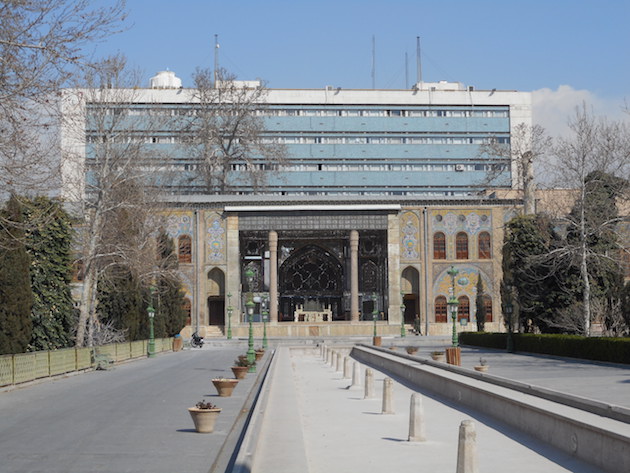
We walk around the corner to the Golestan Palace, once the residence of the royal Qajar family and the site of Mohammad Reza Shah’s coronation in 1967. It’s a perfectly nice palace, though its grandeur is slightly undermined by the drab concrete of the criminal justice building towering over it. The teacher’s pets are wasting no time making themselves known, asking all sorts of questions about where King so and so was coronated during the such and such dynasty. Others, meanwhile, offer some unsolicited gripes about John Boehner and the Citizens United ruling. “Why can’t America be more like France?”
Hadi tells us that the royal garden, where we appear to be standing, was arranged in honor of a water goddess. And, in fairness, the extensive fountain system would make for an impressive sight, if there was any water in it. About half a dozen frustrated men seem to be struggling to fix that, while in the grass off to the side an unattended garden hose gushes freely.
Eventually we end up at the main bazaar. I’m reminded that my mother, who collects Christmas ornaments, had made a passing comment that maybe I could pick something up for her collection. Dad quickly pointed out the long odds of fulfilling this request in the Islamic Republic of Iran. But Iran is full of surprises.
Outside the main entrance to the bazaar, for example, young kids are selling what looks like lingerie out of a cardboard box to women covered in black sheets. The locals don’t seem very impressed with our entourage. I think this apathy has something to do with the fact that the bazaar is jam packed with Iranians buying gifts for Nowruz, the Iranian New Year, and we’re blocking traffic while trying to record videos on our iPads. Our opportunities to interact with average Iranians have been limited, and our guides seem pretty determined to keep it that way.
On the way back to hotel, we drive by the old U.S. embassy. You know, the one from Argo. It is currently home to the Iranian Revolutionary Guard and an impressive collection of anti-American graffiti. There’s also a museum inside, where visitors can see the charred wreckage of Jimmy Carter’s failed attempt to liberate our hostages, but I don’t think we’re invited. Our guides promise an in-depth discussion of the hostage crisis at a later date.
‘Other people might be able to see information you send over this network’
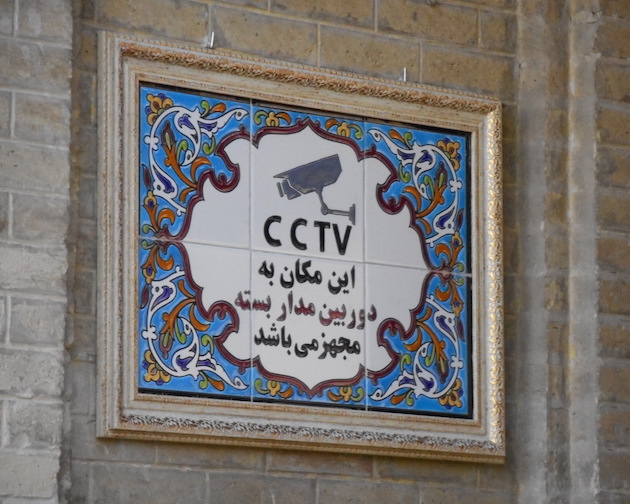
There’s no cell phone service in Iran. Even if you wanted to enable roaming and call home for $12 a minute, you couldn’t, thanks to international sanctions. Fortunately, there’s Viber, an app that lets you make calls and send texts for free over a Wi-Fi connection. In places like Iran, using Viber is a great way to keep and touch with friends and family back home. Until it isn’t.
Our bus is leaving Tehran in less than an hour, so I return to my room after breakfast to finish packing. I’m trying to work out which hotel items I can feasibly smuggle out in my suitcase without causing a scene when there’s a knock at the door. After shoving everything I can manage into my bag and struggling to zip it shut, I peer through the peephole. This would be easier if the door had a peephole.
I can’t see my visitor’s face when I open the door. This is largely due to the fact that there is a smart phone inches from my own face. There’s an obnoxious clicking sound as my photo is taken.
“Good morning, sir. Are you Turkish?” says the sweaty, bespectacled young man standing in front of me. He has a backpack draped over one arm, and a neck pillow on the other, like he just got off a plane. I don’t know what to tell him.
“Can I take photo?”
“No, but I think you already did.”
“Can I come inside your home?”
“No. Why?”
He pulls out an ID card, which I obviously can’t read, and tells me he’s a student at a local university who happens to be conducting a research project on an app called Viber. He shows me his phone. “Do you know?”
This can’t be good. The Basij can’t be far behind, and my screenplay draft is a mess. I’m frantically trying to remember anything incriminating I may have said or done in the last 24 hours. Maybe I complained about the lack of alcohol? Perhaps I expressed some skepticism at Cyrus’s claim that Hillary Clinton personally created ISIS?
This is an extraordinary coincidence, I explain with as much credulity as I can muster. Of course I know about Viber. In fact, I was just using it. Your research sounds fascinating. Why don’t we discuss this further in the lobby with my Iranian guides?
I wait until we’re in the elevator to drop a Columbo on him. “Just one more thing, [whatever his name was]. How did you find my room?” He pretends not to understand the question, but I know he does. When I repeat it for him, he continues to stare blankly. “I asked reception,” he finally says. “I thought you were Turkish.” I hope my guides are around to sort this out.
Fortunately, they are waiting in the lobby. I introduce them to my new friend so they can hash things out in Farsi. They start talking, and he shows them the “student” ID. After a few minutes, he turns to me and apologizes before walking away. “He is a student,” Cyrus explains. “But his research methodology is flawed. Research requires data, not anecdotes.” Says the guy who thinks Hillary spawned the Islamic State.
Hey look, a Jew
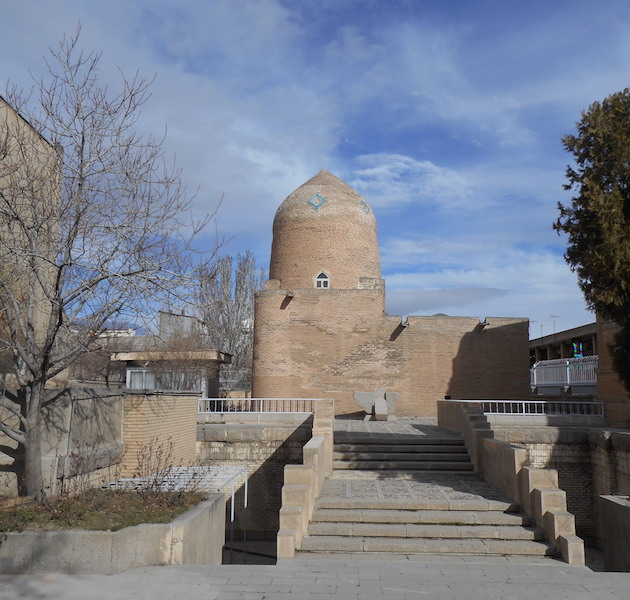
We arrive in the town of Hamadan on the eve of Purim, the Jewish holiday commemorating the heroic efforts of Queen Esther, a former sex slave, and her cousin Mordecai to save the Persian Jews from extermination at the hand of King Ahasuerus. So we might as well visit the tombs of Esther and Mordecai while we’re here.
One imagines they’d be underwhelmed by the state of Iranian Jewry today. Maybe no one considered that Haman (Ahasuerus’s Jew-hating viceroy) was playing the long game. We are accompanied by Najad, a member of the thriving Jewish community in Hamadan that currently numbers 15, who leads us into the tomb. It’s located in a fenced off complex in the middle of a crowded avenue. The act of crossing the street in Iran, by the way, is practically indistinguishable from the act of committing suicide by automobile. The river of cars never stops; you just have to pray that, like Esther’s people, you’ll be spared. The tomb is cold and damp and solemn, as tombs are. When we emerge, an old man is glaring at us from the street. He doesn’t look very excited to see us.
We arrive at the hotel just in time to catch the tail end of Benjamin’s Netanyahu’s address to Congress, which is being carried on Press TV. There’s an intended audience for this speech, but it’s not us. Some folks are listening intently, while others simply scowl at the screen. Netanyahu invokes the story of Esther, who “gave for the Jewish people the right to defend themselves against their enemies”—especially relevant, he says, now that Jews “face another attempt by yet another Persian potentate to destroy us.” It’s agreed among the group that we can’t wait to read the scathing editorial response in the New York Times tomorrow morning. The unstoppable power of the Jewish lobby is discussed over dinner.
Squatting towards Khorramabad
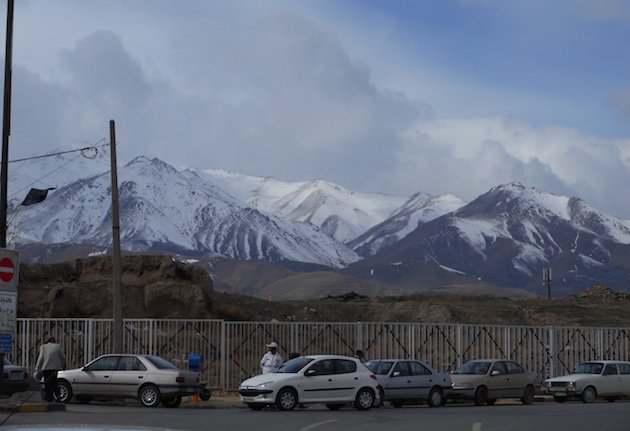
The hours-long bus rides are excruciating at times, but at least the scenery is breathtaking. Flat plains lined on either side by massive, snow-covered peaks. Winding our way through the mountains, we drive past the mud huts of lakeside villages that look untouched since Biblical times. The rest stops along the highway are not as scenic. The bathroom facilities are exclusively of the squat variety, and could all use a good pressure washing. This is a less than ideal situation given the contingency of senior citizens in our group with bad knees.
Like every large transport vehicle in the country, our bus is equipped with a GPS system that must be regularly inspected by the highway patrol in order to monitor our driver’s speed and time behind the wheel. At least that’s what we’re told. It occurs to me that this is one of several reasons why Iran should not be mistaken for a libertarian utopia. I also learn while waiting at these stops that the morbid nature of American “don’t text and drive” campaigns has nothing on the Iranian version, which includes the public display of charred vehicles on spikes along the highway.
We have an “important announcement” on the bus. Iran’s ambassador to the United Nations has written a New York Times op-ed in response to the Israeli prime minister’s speech to Congress. “Netanyahu’s Nuclear Deceptions” is read aloud by a member of the group, and receives a round of applause. The initial reviews are positive. (“Very powerful.” “Powerfully written.”) The Obama administration’s efforts to negotiate a peace deal are “incredibly courageous,” and likely to succeed. There are murmured suggestions that we also read the latest Tom Friedman column, but I am in no mood to have to throw myself off a moving bus. But this reminds me that before the trip is over I should find at least one local taxi driver to bombard with metaphors.
Our bus rolls into Khorramabad, a mid-sized town in the foothills of the Zagros Mountains. Our tour of the local citadel stumbles upon a curious group of school children. They regale us with a barrage of memorized English phrases (“What time is it?”) and, after some lobbying, agree to sing us a song. It’s pretty adorable. Now they want us to sing for them. Someone suggests “God Bless America,” but we ultimately settle on “Do-Re-Mi” from the Sound of Music. I anchor the bass section.
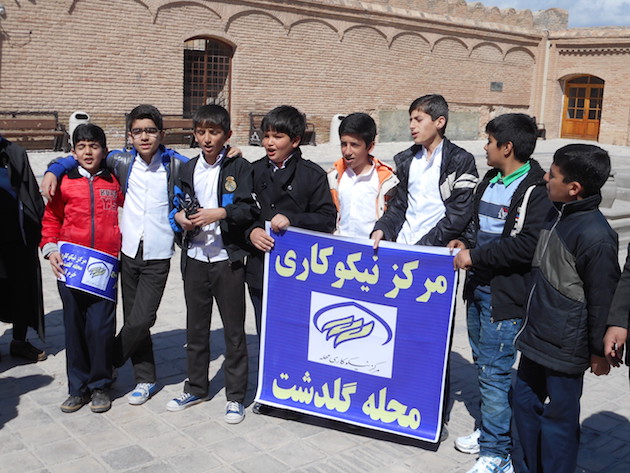
The restaurant we’re supposed to eat at needs a few minutes to set up our tables, so a few of us decide to go for a wander. We pop inside a grocery store, and are immediately drawn to a colorful display at the center—condoms. Every variety (and flavor) imaginable is represented. There is even a “Fun Time” variety pack with a vibrating ring. I doubt Ayotallah Khomeini would approve, given that he sought to disband family planning clinics in the early days of the Islamic Republic with the explicit goal of spurring population growth. The neighboring aisle boasts an impressive selection of toy guns for children.
Ostrich kabob is something of a local specialty in Khorramabad, so that’s what I order for lunch. It’s a little chewy but tastes of ground beef. Not bad. The food in general has been a disappointment. Until now, practically every meal has featured the same menu of options: Lamb kabob, chicken kabob, or fried fish, with or without rice, and a pile of stale, dimpled bread that looks like it was manufactured on a 3-D printer. The lamb kabob is my favorite, but its presentation leaves something to be desired. Think “turd on a plate.”
To keep the lengthy bus trips interesting and enhance our cultural experience, we’ve started an informal lecture series. As it turns out, this is far more enjoyable than discussing U.S. energy policy with liberal Times readers. (“If a train can take you anywhere you want to go in Paris, why not in America?”) Our Iranian guides, Hadi in particular, share fascinating stories about their experiences during the early years of the Islamic Revolution.
A former air traffic controller, Hadi was on duty at Tehran International Airport on Sept. 22, 1980, the first day of the Iran-Iraq War. He describes how he and his colleagues followed standard operating procedure in response to a group of unidentified aircraft approaching the airport. After repeatedly failing to make contact, and operating under the assumption that there was an emergency on board, they proceeded to clear the runways and divert all other air traffic as emergency units gathered on the ground. Moments later, the convoy of Iraqi bombers came into view, and military hotlines started ringing off the hook.
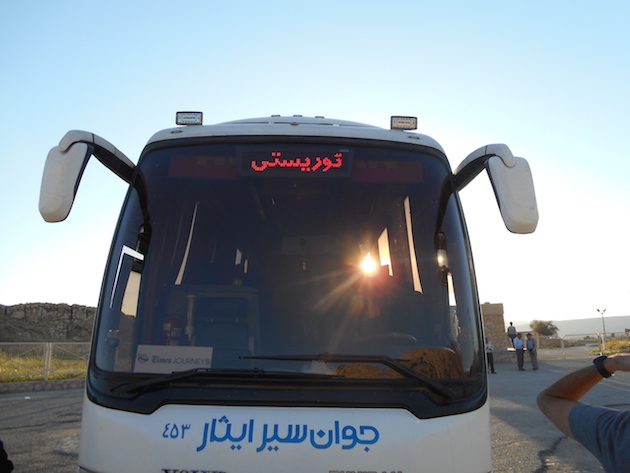
These lectures can also inspire some heated discussions, mostly because even the liberal New York Times crowd can’t abide some of the sizzling hot takes served up by our Iranian guides. Members of the group routinely push back against their rosy depictions of the human rights situation, and bizarre claims that Western culture is to blame for domestic violence in Iran.
Cyrus has read Hillary Clinton’s latest memoir cover to cover. It contains indisputable proof, he says, that her goal as Secretary of State was to travel the world creating ISIS. This is an especially bold claim to make in front of a busload of prospective Hillary Clinton donors, and it does not go over well. However, it’s pretty clear that this general belief—that the United States is actively facilitating the rise of ISIS—is not uncommon in Iran. Hadi chimes in to suggest that the President of Turkey might be working for the CIA, given his tacit support for the Islamic State. “I’m just raising the question.”
What the West called “Holocaust denial,” we’re told, is actually a call for additional “research.” And when someone brings up Khomeini’s fatwa against the author Salman Rushdie, it is dismissed as merely rhetorical, not unlike Barack Obama saying “all options are on the table” regarding the Iranian nuclear program. In any event, Rushdie is an MI-6 operative who was ordered to publish The Satanic Verses in order to embarrass the Supreme Leader. Cyrus eventually concedes that he has “not seen any documents to confirm this.”
Dance like nobody’s watching (because it’s probably illegal)
When we arrive at our lodging for the night—the centuries old castle—it’s already dark. We were running late so we had to cancel our planned stop in Khomein, site of the Supreme Leader’s family home. After checking in, the Cheng brothers (a pair of sixty-something Taiwanese-Americans) and I stumble upon a group of Iranian tourists from nearby Isfahan. They are celebrating the coming of Nowruz by jumping over a fire they’ve prepared in the central courtyard. It’s the sort of celebration Ayatollah Khomeini tried to stamp out in the early days of the revolution, only to be met with strong popular resistance. We are promptly invited to join them in the common room area for what appears to be a dance party.
I sort of feel bad for the Cheng brothers. Their English is harsh and difficult to understand, but they are by far the most gregarious and adventurous members of our tour. Iranians are constantly asking them where they’re from, but never believe them when they say America. “You look China,” one of the Isfahani partiers tells them. “Chop sticks.” We agree to let this blatant microaggression slide.
Dancing to the irregular beat of traditional Iranian music without appearing epileptic is no easy task. Attempting this in the absence of alcohol is especially ill advised. When your dance partner is a 50-year-old Iranian man, well, you have a sense of what I was up against. The locals, of course, were highly amused.
A lovely young lady saunters and we begin. There’s no way this is allowed. You’re not even supposed to shake hands with an Iranian woman unless she initiates. I resolved long before coming here to never allow myself to be honey potted. But this seems like a safe space. Some of the women seated around us have removed their obligatory headscarves. F—k the revolution. My dance partner launches into the universally recognized “Change The Light Bulb” maneuver. I counter with “The Shopping Cart,” and the crowd goes wild.
The Chengs and I are beckoned to the dining hall for dinner—another bland kebab. Ed, a geological expert, complains about the lack of internet access. When we return to the party, the mood has changed. Our guides have situated themselves at the front next to the band, stone-faced. They’re not having any fun, and want to make sure no one else is either. The women are covered. My Persian lady friend leans against the wall with her head down. Four sad dudes attempt to get things going on the dance floor. I am one of them. The music dies down in short order. “Good dancing,” Cyrus says on the way out. “But you need to work on your technique.”

Americans in Iran are generally regarded with a degree of skepticism, but not for the reason you might think. Iranians want to know what you’re doing in Iran, not because they suspect you of plotting a coup, but because they know American passport holders could spend their vacations anywhere else on earth (give or take a few tin-pot communist police states), and feel sorry for you. They are almost always friendly and eager to tell you there are no hard feelings. “Ninety percent of Iranians love America,” is a widely cited statistic, though it’s not clear if this is based on actual data. Eventually, this becomes rather eerie, as if everyone is reading off the same approved script.
Nazri, a student studying computer animation, offered the boldest riff on the “We love America” line, leaning in close to whisper “and Israel,” though I am not convinced this is a 90-10 issue. Moments later, a mullah in a black turban strolled by and leered in our direction. “Very dangerous,” Nazri said after he passed. “I f—king hate them.” Also, can I get him a job in California? Not everyone is so gracious toward Americans. A few (say 10 percent) of the locals, mostly older men, simply said, “Okay,” and sauntered away after I told them my nationality.
Talking to locals seems to always paint a slightly different picture of the country than the one we received from our guides on the bus. One day I stumbled upon a coffee shop run by Armenian Christians. The barista disagreed with Cyrus’s assessment that religious minorities were valued members of Iranian society, and could practice their faith openly without harassment. “No, it’s not good,” he told me. “If I could, I’d leave.”
Visions of Valerie
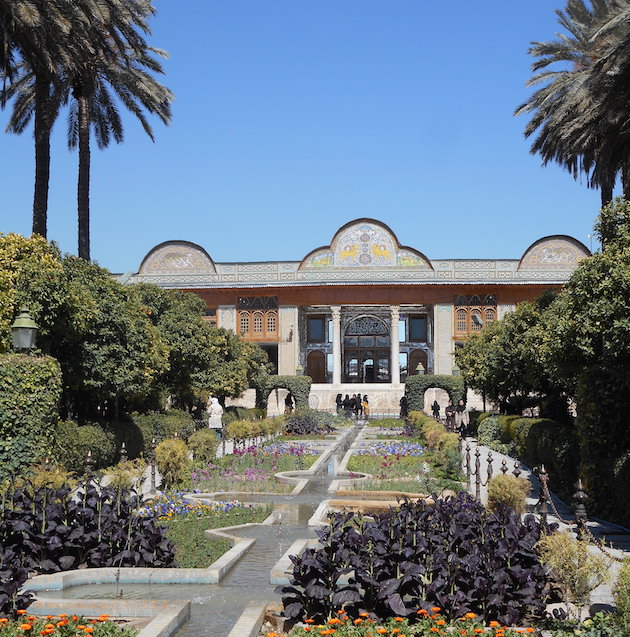
On the road to Shiraz, birthplace of renowned senior White House adviser Valerie Jarrett. Our resident geologist gives a lecture about Iranian rock formations and oil deposits, which inevitably turns into a discussion about fracking. He notes in passing that most of the alleged environmental concerns are bogus. But what does he know? A group of women sitting behind me aren’t buying it, and begin discussing the virtues of government imposed energy quotas for individuals and households. “I’d kill myself,” says the lone dissenter.
Our bus pulls off the side of the road. This can’t be good. In fact, we’ve reached our destination. Well, almost. To get there, we have to essentially trespass through a rustic township and walk about a quarter of a mile through a dry, rocky riverbed. This isn’t the easiest of tasks for some of our less able-bodied tour members. There is a sort of hieroglyph carved into the rock face commemorating an ancient king. It must have been pretty majestic back when there was still a river here. Now there’s just a bunch of trash and some puddles.
The Times has put us up in the Hotel Shiraz, a towering structure on the edge of town that has been plastered onto the side of a mountain overlooking some ruins. Its “five star” accreditation is purely arbitrary, though it is fancier than previous hotels, and even offers a wide range of spa services. When we arrive, the lobby is scattered with bandaged men who look like they’ve all sustained the same injury to the back of the head. Or maybe it’s a religious thing? What we hadn’t considered was that Iran was, apparently, something of a regional mecca for hair transplant surgery, among other procedures. (Only Thailand performs more sex change operations.) It doesn’t take long for us to realize that we might be the only people staying at this hotel who aren’t here for some type of cosmetic surgery.
Taxicab confessions

My Tom Friedman moment has finally arrived. Eager for a night on the town in Valerie’s old stomping grounds, the Cheng brothers and I skip dinner and set off in search of an English-speaking cab driver. His name is Arman, and whether his stories are true or completely made up, they tell you everything you need to know about Iran. The world is a flat circle. Or something like that.
Arman, 28, graduated from university with a degree in petroleum engineering. That’s a pretty good degree in the United States. In Iran, it gets you a cab-driving gig working long hours, seven days a week, for a salary of about $6,000 a year, which is roughly in line with the national average. Like most unmarried Iranians his age, he lives with his parents.
Shiraz is a lively town. Local merchants seem to be competing with one another for the prize of most blindingly obnoxious Times Square-style storefront. Like most places in Iran, there used to be a river here. It has a reputation for being more “relaxed,” but unless I can locate some booze—and I obviously can’t—that seems a distinction without a difference.
The Chengs are absolutely raring to go. It’s slightly unnerving. George, the older one, caused a minor commotion days earlier during a visit to a madrasa when he wandered into a classroom and starting taking photos. That’s just how he rolls. Turn your back on him for a second, and sooner or later he will emerge surrounded by a group of adolescent schoolgirls, smiling incessantly, and taking photos. When the schoolgirls inevitably take an interest in me—solely because I’m the one in our group within 20 years of them—and start lining up to request photos and autographs, George seems genuinely disappointed in me for failing pursue romantic relations with these children. So, naturally, he’s trying to get Arman to take to the hippest hangouts where the hot young Iranians congregate and get up to no good.
As politely as possible, Arman tries to explain that the type of place we’re looking for does not exist. Sure, kids like to party, but this usually happens on the weekends, when groups of friends will load up on booze and go camping in the country, away from the watchful eye of the Islamic Republic. He estimates that roughly half of young Iranians consume alcohol on a semi-regular basis. All you need is a reliable dealer and a lot of cash. A bottle of Johnny Walker Red will set you back about $60—triple what you’ll pay in the United States.
We settle on a hookah lounge Arman has recommended. Despite being reasonably crowded, the place is soul-crushingly silent, apart from the Titanic theme song playing softly in the background. Because we have nothing better to do, we bring Arman with us and start grilling him about politics. Our discussion of the Iranian hostage crisis doesn’t get very far, however, mostly because Arman has never heard of it. But he’s not afraid to criticize the Iranian regime. Like most people who speak English well enough to convey the sentiment, he thinks Ahmadinejad ruined the country. Every Iranian election is a choice between “bad and less bad.”
Arman hopes for better relations between our countries, mostly because he hates it here and wants more than anything to come live in the United States. His uncle has a friend in Louisville, Kentucky. Do I know of any girls back home who would fake marry him for money? I’ll have to get back to him. I ask if he’s ever considered pretending to be gay and claiming refugee status. “Yes,” he says. As if on queue, “Show Me The Meaning of Being Lonely” comes on over the sound system.
On our way out, Arman asks how much we paid to come on this trip. He is stunned when we tell him. “It’s too much,” he says. He’s not wrong.
Veiled privilege

It’s been a while since I’ve checked in on Press TV. To my surprise, Daniel Pipes is on some news program (via satellite) arguing with the host over the extent of Iranian involvement in the war against ISIS. “Strictly an advisory role,” the host insists, before citing a Cato Institute paper criticizing the role of the United States. This evening’s lineup includes a documentary about Palestine—“At The Heart of Siege”—followed by a segment criticizing ISIS over its use of human shields. We’ll also get an update on the BDS movement at the University of Toledo. The host has a cousin in Cleveland.
It’s a long drive north from Shiraz to Isfahan, so our lecture series continues. There is some disagreement over whether the U.S. Navy’s downing of Iran Air 655 in 1988 was a “sheer accident” or the act of “excited soldiers looking for stories.” The discussion becomes more heated when we move on to the topic of women in Iran. One of the first acts of the revolutionary government was to abolish many of the legal protections afforded to women under the Shah, and to lower the legal age of marriage to nine, because that’s what Muhammad would have wanted.
Such things are easily dismissed as barbaric. However, the issue of female dress requirements is more complicated, especially for liberals. On the one hand, modern feminism dictates that forcing women to cover themselves in inherently wrong. On the other, criticizing other cultures is very problematic, as it is often a reflection of Western imperialism and privilege. I’m confused.
I asked a young female student I met in Shiraz about this. She liked wearing a headscarf, she said, because it made her feel “safe” from the lurid stares of the mouthbreathing male hordes. Our Iranian guides loved this little anecdote. “See, it should be a choice,” Hadi says. Except it isn’t. In fact, quite of few Iranian women treat the headscarf requirement as a joke, revealing as much hair as possible with a wisp of cloth dangling off the back of the head.
Isfahan is the most photogenic of the cities we’ve visited. It boasts a series of ornately constructed bridges and, more importantly, an actual river with water in it—but that’s only because the government has turned up the flow for Nowruz. It’s a bit of a sore subject for the locals. Ahmadinejad made a mess of things when he tried to collectivize the water supply. What a dick. What was his deal anyway? I ask Cyrus to weigh in. “You see,” he said, “Ahmadinejad really wanted to have a good relationship with the United States, but…”
“He didn’t realize that denying the Holocaust and threatening to annihilate Israel wasn’t the best way to accomplish that?”
“Exactly.”
‘Welcome to Iran’ (Again)
On the way back to Tehran, we visit the ancient village of Abyaneh—population 250—nestled in the foothills of the Karkas Mountains. It’s said to date back thousands of years to Sassanid times, and is so isolated its residents almost missed out on the Islamic Revolution. These days, according to our guides, the villagers are just a bunch of welfare queens.
There is a pleasant silence as we stroll among the mud brick huts, and for a moment it’s like stepping back in time—until we’re suddenly overtaken by a swarm of Chinese tourists, blitzing the town with gigantic zoom lenses, snapping hundreds of photos per second, including some extreme close-ups of the locals selling dried apples on their doorsteps. Yeah, I know it’s a stereotype but this is literally what happened.
Before leaving, the Chinese manage to instigate a vicious dogfight after throwing some food scraps to the village dogs. This obviously makes for another great photo opportunity, as several members of the group assume the crouched position of professional sports photographers to capture the action. This is kind of amusing at first, until the blood start to flow and it becomes apparent that the black dog isn’t going to make it to the next round. Fortunately, one of the villagers manages to break it up with a baseball-sized rock. I suppose the silver lining in all this is that one of these days Americans are going to concede their long-held title as most obnoxious tourists. Decline has its consequences.

After lunch, we are greeted by an Iranian gentleman superbly dressed in a white over coat, blue sash and sharp leather driving moccasins. He looks like he hasn’t changed clothes since 1979. He interrupts our conversation about how Iran is a peculiar place that becomes more difficult to understand the more you learn about it in order to deliver a public service announcement. “Welcome to Iran,” he says. “We are all Aryans. The Arab Semites, they are a common enemy. They are ruining the world, including your country, by building their satanic mosques. Welcome to Iran.”
We arrive back to the Laleh International in Tehran for a brief stay before heading to airport. I make sure all my electronic devices are turned off, and pick up a copy of one of the English language newspapers. “Iran, Turkmenistan sign 18 agreements,” is the lead story. Also, something about a new link between the United States and ISIS. At the airport, I begin to prepare myself for the grilling I’ll be subjected to upon arrival at Dulles. This will prove to be a waste of time when I am waved through customs without the slightest hesitation—although they did ask if I had spent any time in West Africa.
It’s great to be home.


